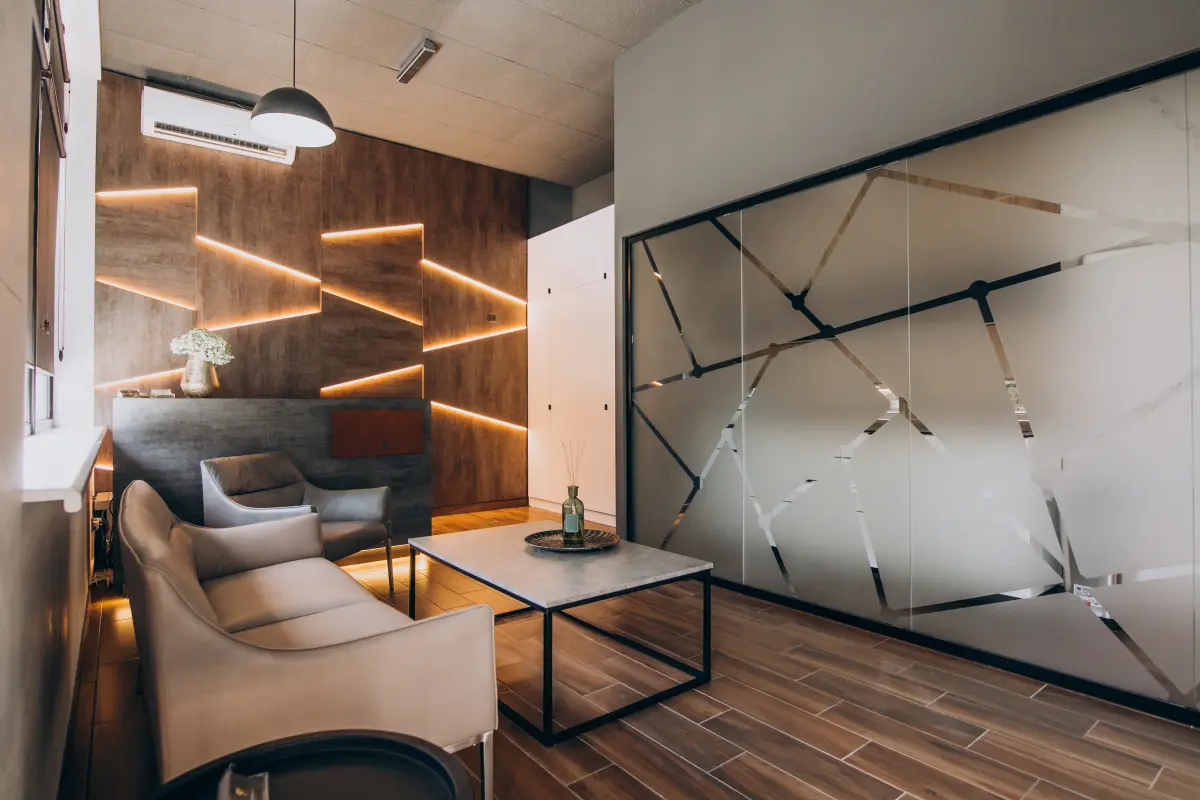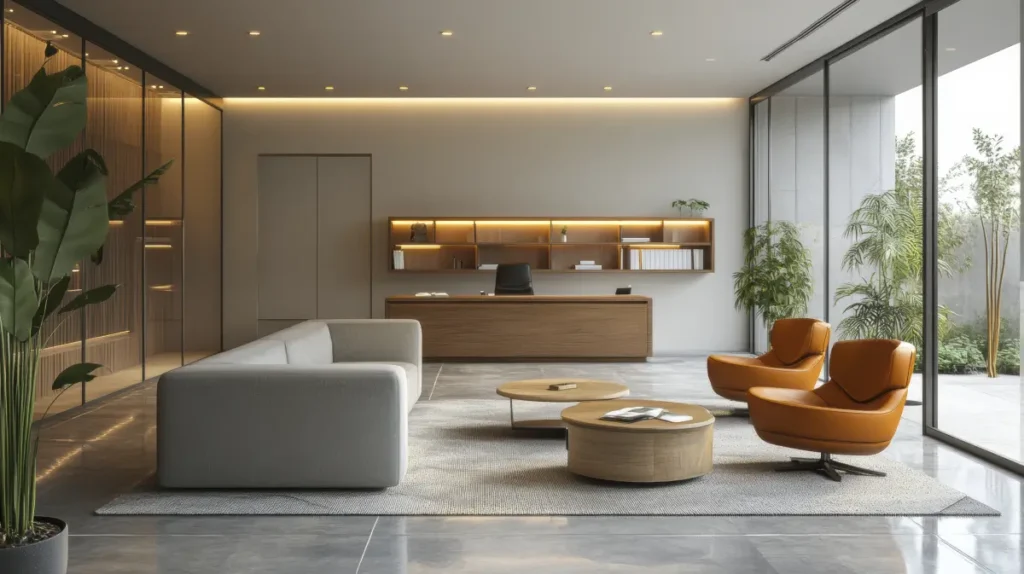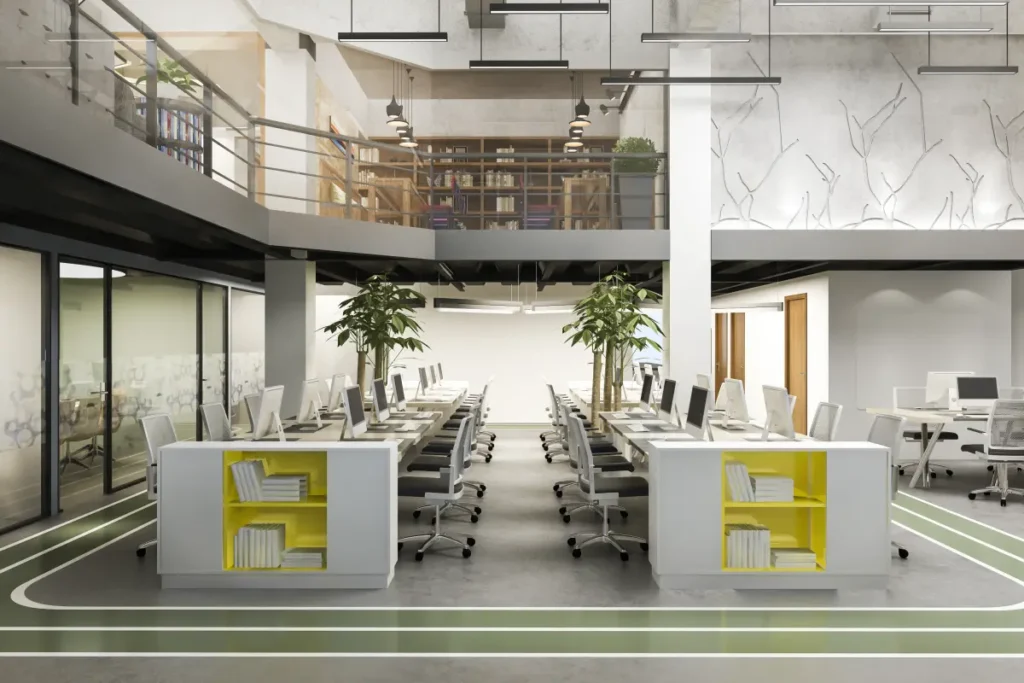
Corporate interior designing is one of the types of interior designing. It is an innovative and creative process that transforms ordinary workplaces into inspiring and productive environments.
A well-designed office space can make a significant difference in employee morale, engagement, and productivity. It reflects a company’s brand identity, values, and culture and provides a positive and engaging work environment for employees.
In this blog, we will discuss the benefits of corporate office interior designing, how to find the right corporate interior design firms, the elements of effective designing, budget-friendly tips, and considerations for future-proof commercial interior designing.
Benefits of corporate interior designing
Here are some major benefits of corporate interior designing:
- Enhancing productivity and employee well-being
- Creating a positive and engaging work environment
- Reflecting brand identity and company culture
1. Enhancing productivity and employee well-being
A well-designed workspace can significantly impact employee productivity and well-being. The layout and organization of the office interior can improve workflow and efficiency, enabling employees to work more effectively.
By incorporating ergonomic furniture and creating comfortable workstations, you can reduce physical strain and promote better posture, leading to decreased employee fatigue and increased productivity.
Additionally, incorporating elements of biophilic design, such as natural light, greenery, and outdoor views, can enhance employee well-being and mental health.
Studies have shown that exposure to natural elements in the workplace can reduce stress, improve mood, and increase overall job satisfaction.
2. Creating a positive and engaging work environment
Corporate interior designing allows you to create a workspace that reflects your company’s values, culture, and brand identity.
By incorporating your brand colors, logo, and other visual elements into the design, you can create a cohesive and memorable environment that reinforces your brand image.
Moreover, a well-designed office can foster a sense of community and collaboration among employees. By creating open and inviting spaces, such as breakout areas, lounge zones, and collaborative workspaces, you can encourage interaction, idea-sharing, and teamwork.
This, in turn, can boost employee engagement and creativity, leading to innovative solutions and improved overall performance.

3. Reflecting brand identity and company culture
Your office space is a reflection of your brand and company culture. It is the first impression that clients, partners, and potential employees get when they visit your workplace.
A thoughtfully designed office that aligns with your brand values can create a positive impression and help build trust and credibility.
Considerations for finding the right interior design partner
Now that you understand the importance of corporate interior design, it’s crucial to find the right corporate interior designers who can bring your vision to life. Here are some key considerations to keep in mind during the selection process:
- Researching and shortlisting design professionals
- Evaluating portfolios and past projects
- Considering budget and timelines
1. Researching and shortlisting design professionals
Start by researching and shortlisting interior design professionals who specialize in corporate spaces. Look for companies with a strong portfolio and positive client testimonials.
You can also ask for recommendations from colleagues or industry peers who have recently undergone office renovations or redesigns.
2. Evaluating portfolios and past projects
When evaluating design professionals, take the time to review their portfolios and past projects. Look for designs that resonate with your aesthetic preferences and reflect the functionality and style you envision for your workplace.
Pay attention to their attention to detail, use of space, and ability to create visually appealing and functional environments.
3. Considering budget and timelines
Budget and timelines are essential factors in any interior design project. Discuss your budget constraints with the corporate interior designers and ensure they can work within your financial limitations without compromising on quality.
Additionally, clarify the project timeline and ensure they can deliver the project within the desired timeframe.
One corporate interior design firm that ticks all these boxes is Veranda Interiors. With a proven track record in corporate interior design, they have successfully transformed numerous workplaces into functional and visually stunning spaces.
From concept development to execution, Veranda Interiors offers comprehensive design solutions tailored to their client’s needs and preferences.

Elements of effective designing
To optimize your workplace through corporate interior design, consider incorporating the following elements:
- Space planning and layout optimization
- Ergonomic furniture and equipment selection
- Lighting design and enhancements
- Color psychology and brand integration
- Acoustic solutions and noise control
- Incorporate technology and smart office features
1. Space planning and layout optimization
Effective space planning is the foundation of a well-designed office. Analyze your workflow and operational requirements to determine the optimal layout for your workplace.
Consider factors such as departmental adjacencies, traffic flow, and the need for collaboration spaces. A well-planned layout can improve communication, efficiency, and overall productivity.
2. Ergonomic furniture and equipment selection
Investing in ergonomic furniture and equipment is crucial for employee comfort and well-being. Choose chairs, desks, and other furniture pieces that promote good posture, provide adequate support, and allow for adjustability.
Ergonomic equipment such as standing desks, monitor arms, and ergonomic keyboards can also contribute to a healthier and more productive work environment.
3. Lighting design and enhancements
Lighting plays a vital role in creating a conducive work environment. Incorporate a combination of natural and artificial lighting to ensure sufficient illumination throughout the office.
Use task lighting to reduce eye strain and glare at individual workstations. Consider installing dimmers or adjustable lighting fixtures to accommodate different tasks and moods.
4. Color psychology and brand integration
Color has a significant impact on mood, productivity, and creativity. Choose colors that align with your brand identity while considering their psychological effects.
For example, blue is often associated with calmness and focus, while yellow stimulates creativity and positivity. Incorporate your brand colors strategically to create a cohesive and visually appealing environment.
5. Acoustic solutions and noise control
Excessive noise can be a major distraction and hinder employee concentration and productivity. Implement acoustic solutions such as sound-absorbing materials, acoustic panels, and noise-canceling systems to create a quieter and more focused work environment.
Consider the acoustics of different areas within the office, such as meeting rooms and open workspaces, to ensure optimal sound control.
6. Incorporate technology and smart office features
In today’s digital age, integrating technology into your office design is essential. Provide ample power outlets, charging stations, and connectivity options to support the use of devices and promote seamless collaboration.
Consider smart office features such as automated lighting, temperature control, and security systems to enhance efficiency and convenience.
Budget-friendly tips
If you have budget constraints, there are still ways to optimize your workplace through cost-effective design strategies:
- Prioritizing key design for investment
- Upcycling and repurposing furniture
- Cost-effective decor and accessories
1. Prioritizing key design areas for investment
Identify the key areas of your office that require the most attention and allocate a more significant portion of your budget to those spaces.
Focus on areas where employees spend the majority of their time, such as workstations, collaborative rooms, and reception areas.
By prioritizing these areas, you can create a significant impact on the overall look and functionality of your office.
2. Upcycling and repurposing furniture
Consider upcycling or repurposing existing furniture to save costs. With a fresh coat of paint or new upholstery, you can transform worn-out furniture pieces into stylish additions to your workspace.
Look for creative ways to repurpose items or consider purchasing second-hand furniture that aligns with your design vision.
3. Cost-effective decor and accessories
Decor and accessories can add personality and style to your workplace without breaking the bank. Look for affordable artwork, wall decals, plants, and decorative elements that reflect your company culture and brand identity.
Consider shopping for these items at local thrift stores or online marketplaces for cost-effective options.

Considerations for future-proof corporate interior designing
To ensure your workplace remains adaptable and relevant in the future, consider the following aspects:
- Flexibility and adaptability in design
- Integration of remote work and collaboration spaces
- Sustainable and green design practices
1. Flexibility and adaptability in design
Design your office space with flexibility and adaptability in mind. Create modular workstations and furniture arrangements that can be easily reconfigured to accommodate changing needs.
Incorporate movable partitions or sliding doors to create flexible spaces that can be adjusted based on the evolving requirements of your business.
2. Integration of remote work and collaboration spaces
With the rise of remote work, it’s essential to design spaces that support both in-person collaboration and virtual interactions.
Create dedicated collaboration areas equipped with video conferencing technology and comfortable seating.
Ensure your office has reliable Wi-Fi connectivity and private spaces where employees can take virtual meetings without distractions.
3. Sustainable and green design practices
Sustainability is a growing concern in corporate interior design. Incorporate eco-friendly materials, energy-efficient lighting, and sustainable practices into your office design.
Use recycled or upcycled materials whenever possible and consider implementing recycling stations throughout the office. Promote green commuting options and provide bike racks or electric vehicle charging stations to encourage sustainable transportation.
Corporate interior designing is a critical investment that can transform ordinary workplaces into inspiring and productive environments.
It can enhance employee well-being, productivity, and engagement, create a positive and engaging work environment, and reflect a company’s brand identity and culture.
Finding the right interior design partner, incorporating effective design elements, implementing budget-friendly tips, and considering future-proof design practices can help to optimize corporate interior designing.
Transform your workplace with a corporate interior designing company like Veranda Interiors and create a well-designed & visually appealing office space that inspires creativity, productiveness, innovation, and collaboration.

 Scroll Down
Scroll Down